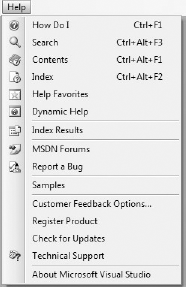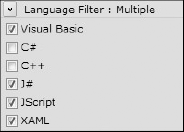5.7. Accessing Help
The easiest way to get help for Visual Studio 2008 is to use the same method you would use for almost every Windows application ever created — press the F1 key, the universal shortcut key for help. If you do so, the first thing you'll notice is that help is contextual. For instance, if the cursor is currently positioned on or inside a class definition in a Visual Basic project, the help window will open immediately with a mini-tutorial about what the Class statement is and how it works, as shown in Figure 5-13.
Figure 5.13. Figure 5-13

This is incredibly useful because more often than not, simply by choosing the right-click context menu and pressing F1, you can go directly to a help topic that deals with the problem you're currently researching.
However, in some situations you will want to go directly to the table of contents, or the search page within the help system. Visual Studio 2008 enables you to do this through its main Help menu (see Figure 5-14).
Figure 5.14. Figure 5-14

In addition to the several help links there are also shortcuts to MSDN forums and for reporting a bug.
5.7.1. Document Explorer
The help commands shown in Figure 5-14, with the exception of Dynamic Help, will open the main help documentation for Visual Studio 2008. Microsoft has introduced a completely new help system, using an interface known as the Document Explorer. Based on a combination of HTML Help, modern web browsers, and the Visual Studio 2008 IDE, the Document Explorer is a feature-rich application in its own right.
Despite the revolutionary changes made to the documentation system, the Document Explorer still presents a familiar interface. It's constructed according to regular Windows application standards: customizable menus, a Toolbar at the top of the interface, a tabbed tool window docked by default to the left side of the main window, and a primary workspace that displays the documents you're working in, as well as the Search pane.
The phrase "tool window" was not used by accident in the previous paragraph. The pane on the left side of Figure 5-15 works in exactly the same way as the tool windows of Visual Studio 2008 itself. In fact, it's actually three tool windows: Contents, Index, and Help Favorites. Each window can be repositioned independently — to float over the main interface or be docked to any side of the Document Explorer user interface. The tool windows can be made to share the same space, as they do by default, or be docked above, below, or alongside each other, as the example in Figure 5-15 illustrates.
Figure 5.15. Figure 5-15

You can use the Help system much as you would previous versions of Help. Using the Contents tool window, you can browse through the hierarchy of topics until you locate the information you're seeking. Alternatively, the Index window gives you direct access to the full index generated by the currently compiled local documentation. Finally, just as in previous versions, a particular topic contains multiple hyperlinks to other related parts of the documentation.
In addition to these traditional means of navigation, the Document Explorer also has a bar at the top of most topics that provides other commands. Figure 5-13 illustrates this with the Class statement topic: directly underneath the heading are two direct hotlinks to sections of the current topic, and two functions that collapse the information or filter it based on a particular language, respectively.
Figure 5-16 shows the latter feature, Language Filter, in action. When the mouse pointer is placed over the Language Filter label, a drop-down list of the main Microsoft languages appears. If you know that the information you want to view is not related to specific languages, you can switch them off by unchecking their respective boxes.
Figure 5.16. Figure 5-16

5.7.2. Dynamic Help
The only help-related command in the Help menu that does not display the Document Explorer interface is Dynamic Help. Using this command will display the Dynamic Help tool window, shown in Figure 5-17. By default, this window shares space with the Properties tool window, but it can be repositioned just like any other part of the Visual Studio IDE.
Figure 5.17. Figure 5-17

The Dynamic Help window contents are constantly updated based on the context in which you are working. This feature works regardless of what mode you're working under, so contextually it updates when you're working in Design or Class Diagram modes, changing as you select or add controls or classes.
Using the Dynamic Help tool window has always been very CPU-intensive. With Visual Studio 2008 the performance of this window has noticeably improved, but it can still adversely affect machines that only barely meet the system requirements for Visual Studio 2008.
